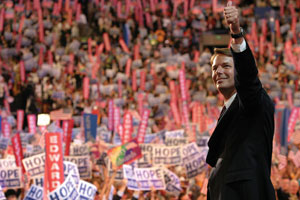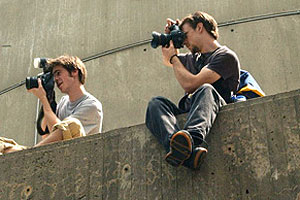 |
|
||
|
|||
“Boot camp” of political reporting
COM student journalists turn in clutch performances at Democratic Convention
By Brian Fitzgerald
|
|
|
|
BU student Peter DiCampo (COM’05) jockeyed among frenzied delegates and fellow journalists to get this shot on the final night of the Democratic National Convention, as John Kerry accepts his party’s presidential nomination. |
|
Screaming. Clapping. Fists pumping. Banners and flags waving. John Kerry had just delivered his acceptance speech at the Democratic National Convention, and the delegates were going crazy. Chris Gaylord stood amidst a blizzard of confetti and balloons on the floor of the FleetCenter and knew he would never forget the moment.
But with people to interview and a deadline to meet, there was no time for the COM print journalism major to fully savor the spectacle. As part of a program cosponsored by COM and BU Summer Term, Gaylord (COM’05) was one of 67 students at BU, 16 of them from other colleges, covering the July 26-29 convention for courses in Political Reporting, Multimedia Publishing, News and Event Photography, and Photo Editing and Design.
However, Gaylord wasn’t writing a story just for his class or COM’s convention Web site, http://onthednc.bu.edu. He was also reporting on the Colorado delegation for the Pueblo Chieftain through the Washington, D.C.–based States News Service (SNS) newswire. He only had time to interview five people, and he struggled to hear the hoarse delegates over the din of the crowd. Needless to say, the Democrats loved their nominee’s speech, filled with anti-Bush rhetoric and his messages “ America can do better” and “Help is on the way.”
“The whole Colorado delegation was cuckoo for Kerry,” says Gaylord. “Their voices were raspy from cheering. Their foreheads dripped with sweat. Their answers to my questions were laced with enthusiasm and heavy with excitement.”
|
|
Democratic vice presidential nominee John Edwards greets the crowd before speaking at the FleetCenter July 28. Photo by Justin Smith |
|
Overseeing the program was Robert Zelnick, COM journalism department chairman, who says that Boston’s first presidential convention provided the setting for “the ultimate practicum in political reporting.” And the students, producing coverage for print, photo, and television clients around the nation, he adds, were able to build their portfolios with the help of “the classic blend of classroom instruction and field experience. The bonus was a huge dose of professional work on deadline, and the rare commodity of credentials to cover a national political convention.”
“Electric” was the word used by several students to describe the climate in the FleetCenter. “There was an odd mix of intensity and optimism in the crowd,” says Paul Imbesi (COM’05), who wrote stories for the Post-Tribune of northwestern Indiana. Lauren Meade (COM’05), covering the Ohio delegation for the Akron Beacon Journal, says that the atmosphere in the building was at times almost overwhelming. “Feeling the kind of energy exuded by 35,000 people all at once is like nothing I’ve ever experienced,” she says.
Rising to the challenge
Mitchell Zuckoff and Dick Lehr, visiting journalism professors and Boston Globe reporters, taught the Political Reporting course. Zuckoff says the students turned in clutch performances in a chaotic setting. “One of the most rewarding parts of this course was watching our students — every one of them, without exception — rise to the challenge,” he says. “They carried themselves as true professionals, hit their deadlines, and never flinched when dealing with the inevitable frustrations and foul-ups that come with covering a major event with 15,000 other journalists.”
Lehr says he could see the excitement — along with the anxiety and exhaustion — in his students’ eyes. “The buildup for them was a bit nerve-wracking,” he says. “They were asking questions like, ‘Why doesn’t the [SNS newswire] editor call me back? Will he take my stories or not?’ There was a general angst until the DNC finally got under way, and that’s when the kids starting hitting on all cylinders.”
|
|
Kerry greets supporters at a rally at the FleetBoston Pavilion on July 12. Photo by Thomas Starkweather |
|
But the best journalists can find themselves running on fumes covering the presidential race without a pit stop. “They even experienced the story fatigue that comes with covering the DNC,” says Lehr. “By Wednesday, you could see them dragging a bit — not for lack of enthusiasm, but because they had been going full tilt for days. Then they pumped themselves up to do it again.”
The angles of the print journalism students’ stories ran the gamut from “a day in the life of a delegate” to covering delegations from a larger perspective, such as the important domestic issues in their respective states. Meade wrote about Ohio as a battleground state, as well as a feature on Sarah Bender, at 17 the convention’s youngest delegate. She says that it was quite the effort to keep up with Bender, who was sought for a slew of media interviews, including talks with MSNBC, ABC, MTV, Fox TV, and Channel One News. Both Meade and Bender got less than five hours of sleep a night that week. “I never expected her to become such a starlet,” says Meade. Neither did Bender, who in the ultimate photo opportunity was featured on the back page of the July 29 Boston Herald greeting the oldest delegate, 90-year-old E. G. Lackey of Florida.
Despite the sometimes circus-like spotlight on Bender, Meade reported that the teenager took her role as a delegate seriously. “With the honor of being the youngest delegate,” says Bender, “I have the responsibility of showing young people that they can make a difference.”
The challenge of covering the delegation from Texas for the Amarillo Globe News, a newspaper in the heart of the fiercely Republican Texas Panhandle, fell to Valerie Conners (COM’05). Still, she says, delegates refused to give up their party’s fight. “I definitely think the Democrats in Texas are optimistic that the tide in Texas is turning away from being staunchly Republican,” says Conners, “and they are far from resigned to being the minority party in a ‘red’ state.”
The camera lens and the Web
Photojournalism students worked alongside the national press corps, supplying pictures to the New York–based Gamma Press photo agency as part of its convention coverage for clients worldwide, and to SNS, which used the students’ material to localize its stories.
“We used the three weeks of preparation prior to the convention to teach the students how to look for a story and how to bring back photos that would tell that story in a compelling way,” says Peter Southwick, a visiting associate professor of journalism. “We gave an intensive, condensed version of our advanced photojournalism courses, and the students responded very well. We pushed them hard, but their desire to learn brought them up to the task.”
|
|
Galen Mook (CAS’06) and T. J. Kirkpatrick (CAS’06) photograph an anarchist protest from above Boylston Street on July 29. Photo by Adrienne Carp (COM’04) |
|
For the Multimedia Publishing class, veteran television producers Susan Walker, an associate professor of journalism, and Bill Lord (COM’59), a journalism professor, prepped 22 students with hands-on shooting, editing, and reporting tips and provided a crash course in the software necessary to launch their Web site. The broadcast students also videotaped stories and interviews for Hearst-Argyle television stations in California, Mississippi, Pennsylvania, and Arkansas.
“The Hearst-Argyle TV partnership was like a final exam — no textbook study, no papers — just find the stories from the delegations and report back to stations which otherwise would not have local coverage,” says Walker. “It was an intense, 24/7 boot camp of political reporting.” Several news directors at the Hearst stations told Walker that these real-life job auditions will undoubtedly result in job offers to a number of the students once they graduate.
Part of the three weeks of preconvention training consisted of three Wednesday press conferences at COM, where panels of experts discussed campaign matters. At the July 21 conference, Michael Dukakis, a former Massachusetts governor and 1988 Democratic presidential candidate, called the extensive security presence and closed roadways in Boston “lunacy,” despite terrorism concerns.
Conners says, however, that most of the media and the delegates took the beefed-up security in stride. “The delegates I covered were completely unfazed by the security,” she says. “I certainly thought it was eerie to see my city turned into what appeared to be a police state, but it also made me feel relieved that all the bases were being covered.”
The COM and Summer Term program, she adds, “was one of the most exciting and intense experiences I’ve ever had. I’m ecstatic that it turned out the way it did, and I hope to see all my classmates reunited at the next convention in 2008.”
![]()
3
September 2004
Boston University
Office of University Relations



